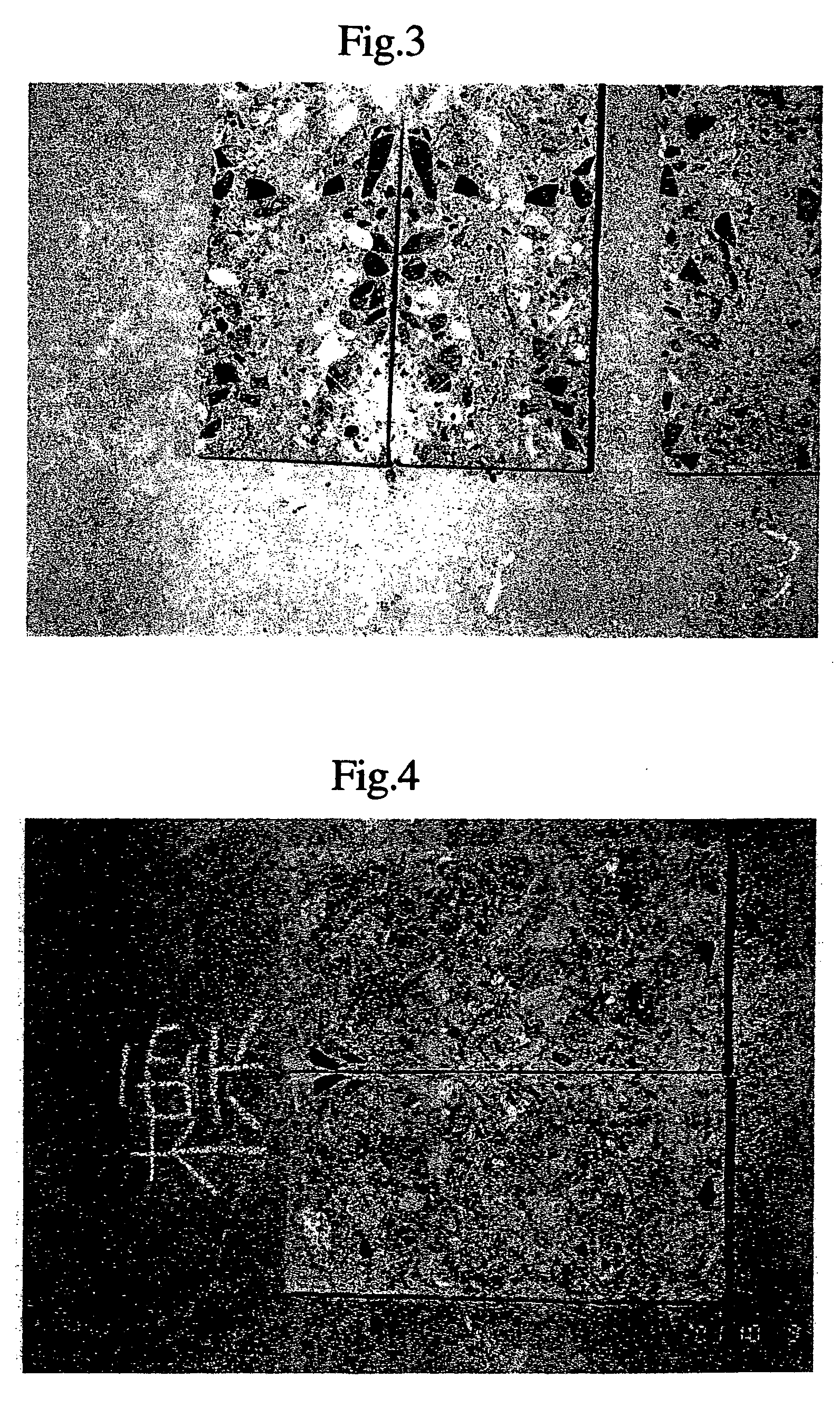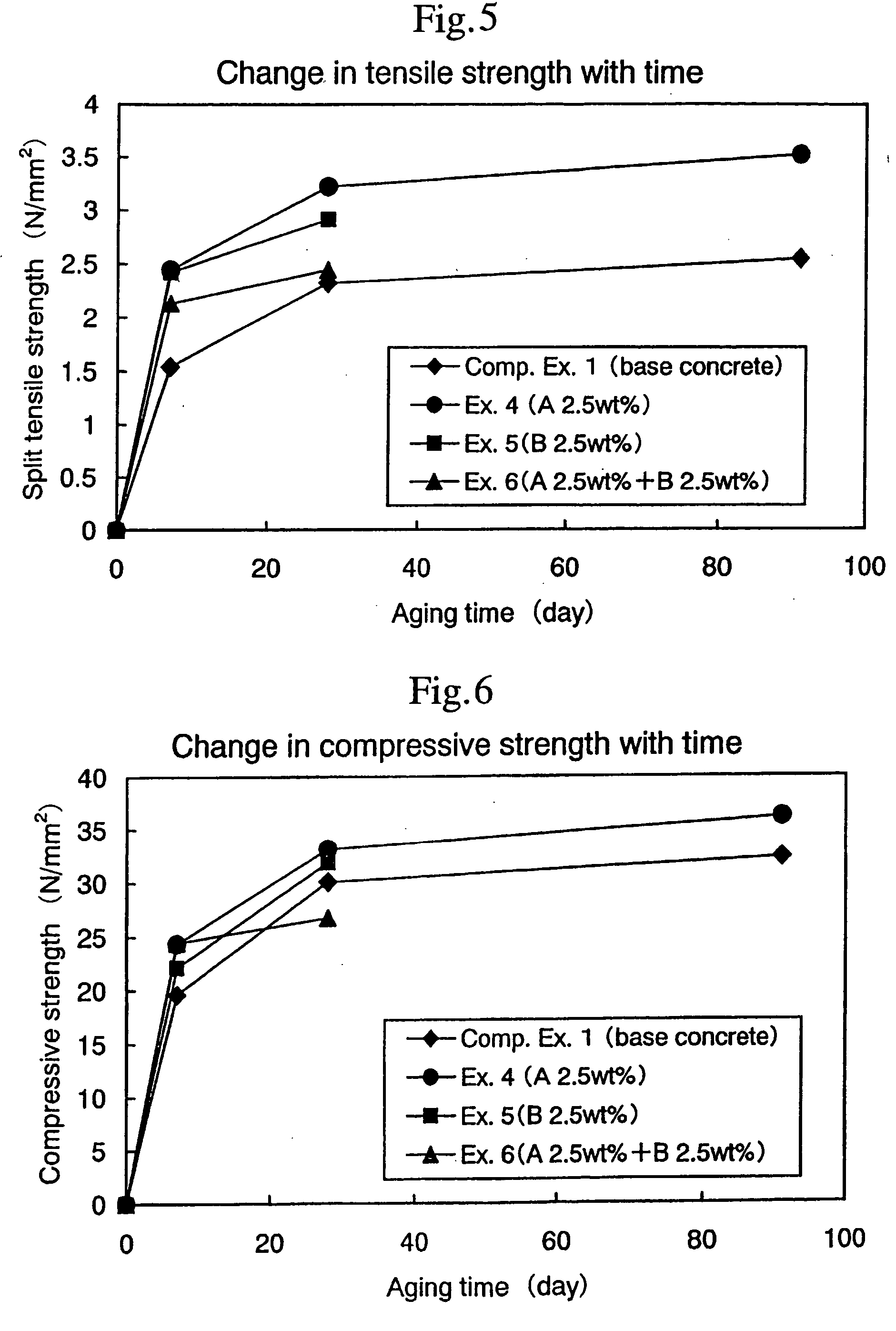Process for producing a concrete and a mortar
- Summary
- Abstract
- Description
- Claims
- Application Information
AI Technical Summary
Benefits of technology
Problems solved by technology
Method used
Image
Examples
example 1
Production of Admixtures A and B
[0073] 120 g of fumaric acid was charged into a vessel filled with 15 kg of water held at 60° C., and dissolved with stirring. Then, while stirring was continued, 25 kg of water glass (“JIS No. 3 Sodium Silicate”, made by Toso Sangyo K.K.) was added. At this time, a viscosity was much increased temporarily in a portion to which the water glass was added, but the whole solution was homogenized with stirring. This procedure was repeated, and a wholly uniform aqueous solution free from an insoluble matter was prepared by adding the total amount of the water glass.
[0074] The water glass used here contained from 9 to 10% by weight of sodium oxide (Na2O: MW=61.98) and from 28 to 30% by weight of silicon dioxide (SiO2: MW=60.09). Assuming the water glass contained 9.5% by weight of sodium oxide and 29% by weight of silicon dioxide upon employing the intermediate values, a [metal / silicon] ratio was 0.64. Further, a [metal / carboxyl group] ratio (ratio of a s...
example 2
Production of Admixture C
[0077] An aqueous solution was prepared in the same manner as in Example 1 except that 1,440 g of citric acid was used instead of 120 g of fumaric acid. A [metal / carboxyl group] ratio of a sodium atom to a carboxyl group of citric acid (C6H8O7: MW=192.13) as a tribasic acid was 3.4.
[0078] The resulting aqueous solution was solidified and dried as in Example 1. After the drying, particles slightly stuck to one another were separated, and then applied to a 2.5 mm-mesh sieve, and particles passed through the sieve were designated admixture C. When admixture C was applied to a 1.25 mm-mesh sieve, approximately 10% by weight thereof was passed through the sieve, and approximately 90% by weight thereof remained on the sieve. The water content of the thus-obtained admixture C was measured according to JIS K0101-16.2, and found to be 30% by weight. Since admixture C had a moisture absorption, it was stored and used as in Example 1.
example 3
Production of Admixture D
[0079] Admixture A produced in Example 1 was charged on a frying pan, and heated on a gas heater. Since water in the admixture was evaporated by the heating, the admixture particles were swollen. However, 5 minutes later, the swelling was no longer observed, and the heating was completed. After cooling, particles slightly stuck to one another were separated, and then applied to a 2.5 mm-mesh sieve. The particles passed through the sieve were designated admixture D used in this Example. When admixture D was applied to a 1.25 mm-mesh sieve, approximately 10% by weight thereof was passed through the sieve, and approximately 90% by weight thereof remained on the sieve. The water content of the thus-obtained admixture D was measured according to JIS K0101-16.2, and found to be 0% by weight. Since admixture D had a moisture absorption, it was stored and used as in Example 1. Thus, admixture D does not contain water. Accordingly, even when cement is previously ble...
PUM
| Property | Measurement | Unit |
|---|---|---|
| Percent by mass | aaaaa | aaaaa |
| Percent by mass | aaaaa | aaaaa |
| Percent by mass | aaaaa | aaaaa |
Abstract
Description
Claims
Application Information
 Login to View More
Login to View More - R&D
- Intellectual Property
- Life Sciences
- Materials
- Tech Scout
- Unparalleled Data Quality
- Higher Quality Content
- 60% Fewer Hallucinations
Browse by: Latest US Patents, China's latest patents, Technical Efficacy Thesaurus, Application Domain, Technology Topic, Popular Technical Reports.
© 2025 PatSnap. All rights reserved.Legal|Privacy policy|Modern Slavery Act Transparency Statement|Sitemap|About US| Contact US: help@patsnap.com



